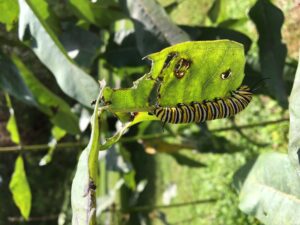Plants That Host Butterfly Larvae
go.ncsu.edu/readext?794155
en Español / em Português
El inglés es el idioma de control de esta página. En la medida en que haya algún conflicto entre la traducción al inglés y la traducción, el inglés prevalece.
Al hacer clic en el enlace de traducción se activa un servicio de traducción gratuito para convertir la página al español. Al igual que con cualquier traducción por Internet, la conversión no es sensible al contexto y puede que no traduzca el texto en su significado original. NC State Extension no garantiza la exactitud del texto traducido. Por favor, tenga en cuenta que algunas aplicaciones y/o servicios pueden no funcionar como se espera cuando se traducen.
Português
Inglês é o idioma de controle desta página. Na medida que haja algum conflito entre o texto original em Inglês e a tradução, o Inglês prevalece.
Ao clicar no link de tradução, um serviço gratuito de tradução será ativado para converter a página para o Português. Como em qualquer tradução pela internet, a conversão não é sensivel ao contexto e pode não ocorrer a tradução para o significado orginal. O serviço de Extensão da Carolina do Norte (NC State Extension) não garante a exatidão do texto traduzido. Por favor, observe que algumas funções ou serviços podem não funcionar como esperado após a tradução.
English
English is the controlling language of this page. To the extent there is any conflict between the English text and the translation, English controls.
Clicking on the translation link activates a free translation service to convert the page to Spanish. As with any Internet translation, the conversion is not context-sensitive and may not translate the text to its original meaning. NC State Extension does not guarantee the accuracy of the translated text. Please note that some applications and/or services may not function as expected when translated.
Collapse ▲
Monarch caterpillars feed on milkweed plants exclusively. Plant milkweed in your garden to benefit Monarch butterflies!
Native plants are important to native insects. Butterfly larval host plants are plants on which butterfly females lay eggs. The subsequent larvae of the the butterfly then feeds on the host plant. This feeding does not harm the plants and often these plants are the only food the caterpillars will eat. Choose native plants for your landscape when you can to benefit butterflies!
| Butterfly | Caterpillar Host Plants |
|---|---|
| Pipevine swallowtail | pipevines (Aristolochia spp.) |
| Zebra swallowtail | pawpaw (Asimina triloba) |
| Black swallowtail | parsley family – parsley, dill, fennel, carrot, Queen Anne’s lace, Golden Alexanders (Zizia aurea), rue family – common rue |
| Giant swallowtail | northern prickly-ash (Zanthoxylum americanum), common rue |
| Eastern tiger swallowtail | tuliptree (Liriodendron tulipifera), wild black cherry (Prunus serotina), ash (Fraxinus spp.) |
| Spicebush swallowtail | spicebush (Lindera benzoin), sassafras (Sassafras albidum) |
| Cabbage white (non-native) | mustard family – cabbage, broccoli, cauliflower, Brussels sprouts, garlic mustard, (invasive non-native), winter-cress |
| Clouded sulphur | clovers |
| Orange sulphur | alfalfa, clovers |
| American copper | sheep sorrel, docks |
| Banded hairstreak | oaks (Quercus spp.), hickories (Carya spp.), black walnut (Juglans nigra) |
| Gray hairstreak | flowers and seeds of – tick-trefoils, bush-clovers, clovers, mallows, hibiscus |
| Henry’s elfin | redbud (Cercis canadensis), American holly (Ilex opaca), blueberries (Vaccinium spp.) |
| Eastern tailed blue | flowers and seeds of – clovers, bush-clovers, tick-trefoils, sweet clovers |
| Baltimore | white turtlehead (Chelone glabra) |
| Spring azure/summer azure | buds and flowers of – flowering dogwood (Cornus florida), wild black cherry (Prunus serotina), viburnums, blueberries, meadow-sweet (Spiraea spp.), New Jersey tea (Ceanothus americanus), wing stem (Verbesina alternifolia) |
| Variegated fritillary | violets and pansies |
| Great spangled fritillary | violets |
| Meadow fritillary | violets |
| Silvery checkerspot | ox-eye sunflower (Heliopsis helianthoides), sunflowers (Helianthus spp.), black-eyed Susans (Rudbeckia spp.), wing stem (Verbesina alternifolia), coneflowers (Echinacea spp.) |
| Pearl crescent | asters (Symphyotrichum spp.) – excluding white wood aster (Eurybia divaricata) |
| Question mark | hackberry trees (Celtis spp.), elms (Ulmus spp.), nettles |
| Eastern comma | nettles, hops, elms (Ulmus spp.) |
| Mourning cloak | willows (Salix spp.), elms (Ulmus spp.), aspens (Populus spp.), birches (Betula spp.), hackberry tree (Celtis spp.) |
| American lady | pussytoes (Antennaria spp.), pearly everlasting, fragrant cudweed |
| Painted lady | thistles (some are invasive non-natives), mallows, hollyhocks, asters, legumes and many others |
| Red admiral | nettles, false nettle |
| Common buckeye | English plantain, common plantain, figworts, vervains, snapdragon, toadflax |
| Red-spotted purple | cherries (Prunus spp.), willows (Salix spp.), aspens (Populus spp.), serviceberries (Amelanchier spp.), birches (Betula spp.), hawthorns (Crataegus spp.), sweet crabapple (Malus coronaria) |
| Viceroy | willows (Salix spp.), aspens (Populus spp.) |
| Hackberry & Tawny emperors | hackberry trees (Celtis spp.) |
| Appalachian brown | sedges (Carex spp.), bulrush |
| Little wood satyr | bluegrasses, orchard grass |
| Common wood nymph | purpletop grass (Tridens flavus), poverty grass, big bluestem, little bluestem |
| Monarch | milkweeds (Asclepias spp.) |
| Silver-spotted skipper | black locust (Robinia pseudoacacia), honeylocust (Gleditsia triacanthos), tick-trefoils, hog-peanut and other legumes |
| Wild indigo duskywing (skipper) | wild indigo (Baptisia tinctoria), blue false indigo (Baptisia australis), crown-vetch (invasive non-native) |
| Common checkered skipper | mallows, sidas, velvet-leaf, hollyhock |
| Peck’s skipper | rice cutters (Leersia oryzoides), bluegrasses |
| Little glassywing (skipper) | purpletop grass (Tridens flavus) |
| Zabulon skipper | purpletop grass (Tridens flavus), lovegrass |
Chart prepared by York County Master Gardener℠ Volunteer Debra Carman, February 2017
Butterfly Larval Host Plant List




